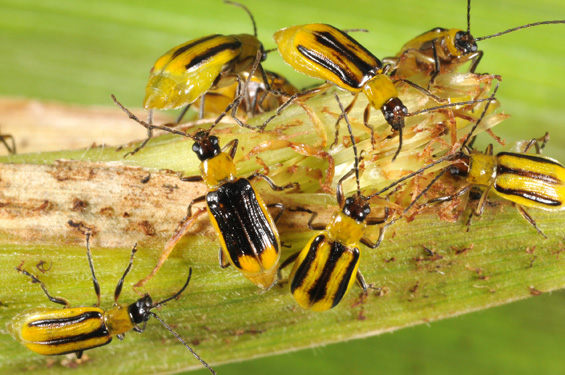
Common Name: Western corn rootworm
Scientific Name: Coleoptera: Diabrotica virgifera LeConte
Status: A serious pest of corn
Damaging Stage: Adult beetle and grubs
Biology: Adults are about �-inch long and yellow with three black stripes running down the lengths of the wing covers. The wing covers of males may be entirely black except for narrow yellow margins and yellow tips. Western corn rootworm larvae are cream-colored and about � inch long. They have a brown head capsule and are generally found in corn or soybean fields.
The western corn rootworm life cycle is similar to the northern corn rootworm. Adults emerge in mid-summer and females begin laying eggs about two weeks after emergence. The eggs hatch the following spring. The newly hatched larvae find their way to corn roots, bore in, and begin feeding. The larval stage lasts about three weeks, then they move into the soil to pupate. The adults emerge in the summer.
Injury: Larvae feed on the root-hairs and can reduce crop yield by 10% or more. As the roots are destroyed, the plant cannot absorb water. Heavy larval infestations can cause extreme �goosenecking� or lodging of corn stalks. Adults prefer to feed on leaf blades.
Action Threshold: Sticky cards should be placed randomly throughout a corn field for monitoring purposes. The action threshold is generally four beetles recovered in a sticky trap in one day which usually results in some roots with feeding scars. If four or more beetles are found, a chemical control is recommended.
Management: Western corn rootworms are difficult to manage with chemical controls alone. Crop rotation practices are a popular cultural method of regulating populations. However, new rootworm variants that can feed in soybean and corn fields are forcing growers to consider new control options.
|